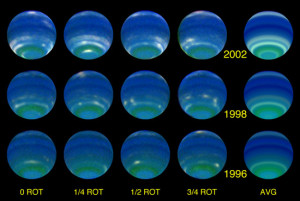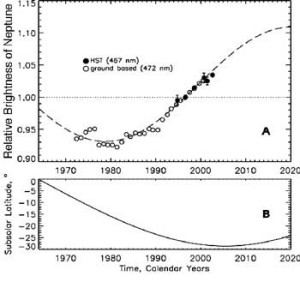Neptune’s Increased Brightness Provides Evidence for Seasons
April 22, 2002, Madison, WI—Hubble Space Telescope (HST) imaging observations in August 2002 show that Neptune’s brightness has increased significantly since 1996 (FIGURE 1) and now appears to be consistent with a simple seasonal variation model (FIGURE 2). These results are described by L. A. Sromovsky, P. M. Fry, and S. S. Limaye of the University of Wisconsin–Madison’s Space Science and Engineering Center, and K. Baines of NASA’s Jet Propulsion Laboratory, in an upcoming paper in the solar system science journal Icarus (Volume 163, Issue 1).

FIGURE 1. Click on the image above for a higher resolution image. These individual color composite images used HST filters F467M (467 nm), F673N (673 nm), and F850LP (850 nm–1000 nm) as blue, green, and red components, respectively. Each image component was also processed to reduce limb darkening and enhance contrast, and is a blend of several images taken at different longitudes. The images for each year were processed the same as for other years so that relative temporal changes are meaningful. The first four columns display views at 0, 1/4, 1/2, and 3/4 rotations, to show the distributions of discrete features. The last column displays the longitudinal average, showing that latitude bands near 30 S, 45 S, and 67 S, have increased dramatically in brightness. This image composite and rotational movies are available on the Space Telescope Science Institute Web page.
Comparing August 2002 observations to similar observations in 1996, the authors found that Neptune’s reflectivity averaged across the planet’s face (disk-averaged) increased by 3.2% at 467 nm (blue), 5.6% at 673 nm (red), and 40% in the 850 nm–1000 nm band (near infrared). These changes result from even larger brightness increases in restricted latitude bands, reaching 100% in some cases. The reason for the increases may be seasonal forcing, which is the seasonal variation in local solar heating.
Because Neptune’s equatorial plane is inclined 29º to its orbit plane, it is subject to seasonal solar forcing during its 164.8-year orbit of the sun. The resulting local variation in incident sunlight is similar in fractional amplitude to that on the earth, which has a 23.5º inclination, but the absolute variation is 900 times smaller and the rate of change is slower by an additional factor of 165. Remarkably, there is now evidence that Neptune is responding measurably to this weak forcing (of the sun’s heat). The long record of disk-averaged observations from Earth provides a key piece of evidence. When blue-filter (467-nm) observations with the Hubble Space Telescope from 1994 to 2002 are added to blue-filter (472-nm) Earth-based results of Lockwood and Thompson, the combined disk-averaged variation from 1972 to 2002 is consistent with a simple seasonal model having a hemispheric response delay relative to solar forcing of ~30 years (~73% of a full season).

FIGURE 2. Seasonal model compared to the observed brightness variation of Neptune. The upper plot (A) shows the disk-averaged relative reflectivity of Neptune at blue wavelengths, as inferred by 1972–2000 ground-based observations at 472 nm (open circles), and from 467 nm HST observations (filled circles) from 1994 through 2002. These results are scaled to have unit value in August 1996. The best-fit seasonal model (dashed curve) has its peak delayed 15.1 years relative to the upcoming hemispheric solar forcing peak in 2005, when the subsolar latitude will be at its southern extreme, as shown in the lower plot (B). This delay in the brightness peak is half the delay in the dynamical response to solar forcing, a consequence of geometric effects.
In this model, dynamic activity that produces brighter cloud features is postulated to increase in proportion to the daily average incident sunlight, thus brightening the hemisphere that is tipped toward the sun and darkening the hemisphere that is tipped away. Because the hemisphere that is tipped toward the sun is also tipped toward the earth, not only is that hemisphere brighter, but a larger fraction of it is visible. This would lead to peaks in disk-averaged brightness at each solstice (maximum latitudinal excursion of the sun), except for one complicating factor. Because Neptune is very cold, with an effective radiating temperature only 59 K above absolute zero, it cannot reach rapid thermal equilibrium with the variation in solar heating. This results in a delayed response to solar forcing, and a delay in the time of Neptune’s brightness maxima. A delay of about 30 years in dynamic response is consistent with the observations and results in a delay of about 15 years in the brightness maxima. If this model is correct, Neptune will continue to brighten for another 20 years.
Contact: Lawrence A. Sromovsky, (608) 263-6785
For past features and columns, see SSEC’s News page.
